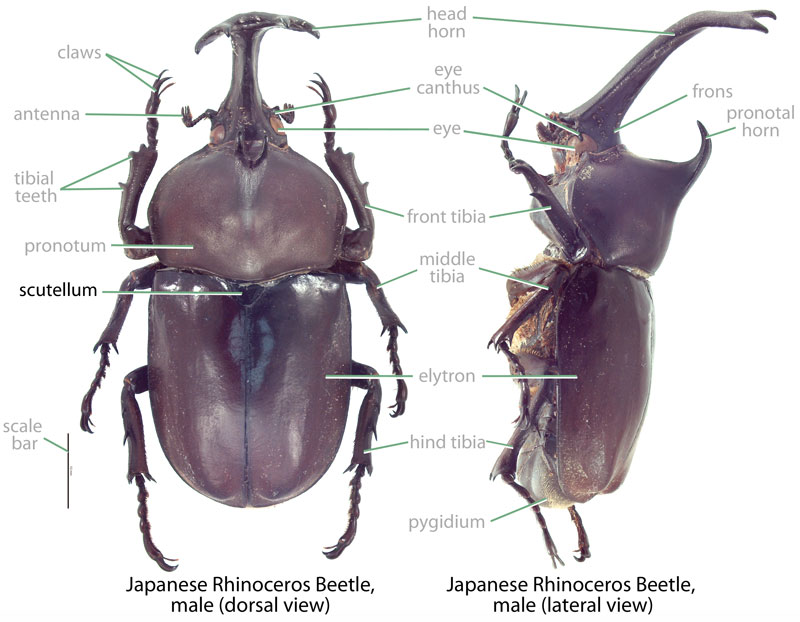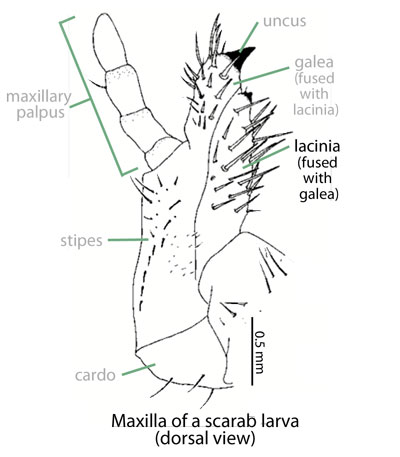Beneficial
none known
Family: Trogidae Subfamily: Troginae Genus: Omorgus Species: Omorgus procerus (Harold, 1872)
none available
Total body length 10.0–15.0 mm (0.39–0.59 in). Body shape strongly convex dorsally, flattened ventrally; appearance warty; often encrusted with debris. Color dark gray to reddish-brown. Abdomen extremely flat when viewed laterally. Pronotumpronotum:
the dorsal surface of the thorax
 with base scalloped and basal anglebasal angle:
with base scalloped and basal anglebasal angle:
in reference to the pronotum, the basal and lateral corner
obtuse. Scutellumscutellum:
the triangular portion of the thorax between the bases of the elytra
 hastatehastate:
hastatehastate:
somewhat diamond-like in shape
. ElytraElytra:
the hardened and chitinous wing-cover of a beetle that protect and overlie the flight wing
with patches of short, reddish-brown hairs. Middle tibiatibia:
a segment of the leg articulated with the tarsus and femur
 with numerous fine teeth at outer margin.
with numerous fine teeth at outer margin.
Undescribed. For Omorgus spp. (Ritcher, 1966Ritcher, 1966:
Ritcher P. 1966. White grubs and their allies: a study of North American scarabaeoid larvae. Oregon State University Monographs, Studies in Entomology 4: 1-219.): Grub C-shaped, not hump-backed, cylindrical, whitish. Maxillamaxilla:
set of paired mouthparts located posterior to the mandibles
with galeagalea:
outer branch or lobe of the maxilla
 and lacinialacinia:
and lacinialacinia:
inner portion of the maxilla distinctly separated. AntennaeAntennae:
distinctly separated. AntennaeAntennae:
paired sensory organ on head, formed from numerous segments
 with 3 segments, lacking distaldistal:
with 3 segments, lacking distaldistal:
situated away from the point of articulation, thus usually furthest from the body
sensory cone on second segment. Distaldistal:
situated away from the point of articulation, thus usually furthest from the body
segment of antennaeantennae:
paired sensory organ on head, formed from numerous segments
 much reduced in size. Epipharynxepipharynx:
much reduced in size. Epipharynxepipharynx:
lobe on the interior surface of the labrum or clypeus
with tormaetormae:
in scarab larvae, sclerotized structures on the ends of the clypeolateral suture extending towards the mesal line
united mesallymesally:
at or near midline of body
. Legs 4-segmented, never with stridulatory organ. Spiraclesspiracles:
opening on the abdomen or thorax through which air enters and exits the body
 cribriformcribriform:
cribriformcribriform:
sieve-like in appearance
.
Northeastern Africa, western Asia. This species is broadly distributed across arid and semi-arid regions of Africa and western Asia, occurring from India through the Middle East, Egypt, and into the Horn of Africa and across the Sahel (Zidek, 2013Zidek, 2013:
Zidek J. 2013. Checklist and bibliography of the Trogidae (Coleoptera: Scarabaeoidea). Insecta Mundi 314: 1-38. full text (accessed 2015)).
None. LarvaeLarvae:
the immature form of an insect; in scarabs, also called grub or white grub; preceded by the egg stage, followed by the pupal stage
 of this species appear to be specialized egg predators of the desert locust (Schistocerca nitens [formerly S. gregaria]) (Roffey, 1958Roffey, 1958:
of this species appear to be specialized egg predators of the desert locust (Schistocerca nitens [formerly S. gregaria]) (Roffey, 1958Roffey, 1958:
Roffey J. 1958. Observations on the biology of Trox procerus Har. (Coleoptera, Trogidae), a predator of eggs of the desert locust, Schistocerca gregaria (Forsk.). Bulletin of Entomological Research 49: 449-465.). The adult diet is unclear, but the related bark-like hide beetle (Omorgus suberosus) feeds upon late stage carrion and other animal debris as adults (Ratcliffe and Paulsen, 2008Ratcliffe and Paulsen, 2008:
Ratcliffe B and Paulsen P. 2008. The scarabaeoid beetles of Nebraska (Coleoptera: Scarabaeoidea). Bulletin of the University of Nebraska 22: 138-248.).
(Roffey, 1958Roffey, 1958:
Roffey J. 1958. Observations on the biology of Trox procerus Har. (Coleoptera, Trogidae), a predator of eggs of the desert locust, Schistocerca gregaria (Forsk.). Bulletin of Entomological Research 49: 449-465.): Eggs are deposited in loose soil near egg cases of the desert locust (Schistocerca nitens) and emerge after 2–3 days. LarvaeLarvae:
the immature form of an insect; in scarabs, also called grub or white grub; preceded by the egg stage, followed by the pupal stage
 grow rapidly with the final instarinstar:
grow rapidly with the final instarinstar:
in scarabs, one of the three larval growth phases (i.e., first instar, second instar, third instar), each ending with the larvae molting to the next phase
reached in an average of 14 days. During this time, grubs move through the soil feeding on the locust eggs, often leaving behind small mounds of dirt. The final adult form is reached after an average of 60 days.
None. This species feeds upon the eggs of the desert locust (Schistocerca nitens), a destructive pest in the Hawaiian Islands (Latchininsky, 2008Latchininsky, 2008:
Latchininsky A. 2008. Grasshopper outbreak challenges conservation status of a small Hawaiian island. Journal of Insect Conservation 12: 343–357. full text (accessed 2015)).
Recorded, not established. This species was intentionally released in Hawaii as a biocontrol agent. In 1966, specimens were released on Sand Island in Honolulu to combat the invasiveinvasive:
a species that has recently arrived to a new location, usually via human activity, causing notable economic and/or ecological damage
desert locust (Schistocerca nitens) (Davis and Krauss, 1967Davis and Krauss, 1967:
Davis C and Krauss N. 1967. Recent introductions for biological control in Hawaii-XII. Proceedings of the Hawaiian Entomological Society 19:375-380. full text , DOI (accessed 2015)), a generalist herbivore with periodic outbreaks that can cause serious ecological damage (Latchininsky, 2008Latchininsky, 2008:
Latchininsky A. 2008. Grasshopper outbreak challenges conservation status of a small Hawaiian island. Journal of Insect Conservation 12: 343–357. full text (accessed 2015)). Omorgus procerus failed to establish in Hawaii (Nishida, 2002Nishida, 2002:
Nishida G (editor). 2002. Hawaiian terrestrial arthropod checklist, fourth edition. Bishop Museum Technical Report 22: 1-313.).
Not established or recorded. There are no records of this species from Guam.
In Hawaii, this species was intentionally released but did not establish (Nishida, 2002Nishida, 2002:
Nishida G (editor). 2002. Hawaiian terrestrial arthropod checklist, fourth edition. Bishop Museum Technical Report 22: 1-313.).
Omorgus procerus is one of three hide beetles (Trogidae) known from Hawaii and Guam. The other two species are Trox scaber and Omorgus suberosus. These species are separated based on examination of the scutellumscutellum:
the triangular portion of the thorax between the bases of the elytra
 (hastate in O. procerus versus parabolic in T. scaber), the pronotumpronotum:
(hastate in O. procerus versus parabolic in T. scaber), the pronotumpronotum:
the dorsal surface of the thorax
 (pronotal base scalloped and the basal anglebasal angle:
(pronotal base scalloped and the basal anglebasal angle:
in reference to the pronotum, the basal and lateral corner
obtuse in O. procerus versus pronotal base weakly sinuatesinuate:
gently curved (specifically of margins or edges); often in reference to the clypeus
and basal anglebasal angle:
in reference to the pronotum, the basal and lateral corner
quadrate T. scaber), and the middle tibiatibia:
a segment of the leg articulated with the tarsus and femur
 (O. procerus with a row of fine teeth along outer margin versus teeth lacking in O. suberosus).
(O. procerus with a row of fine teeth along outer margin versus teeth lacking in O. suberosus).
Afromorgus procerus (Harold), Trox procerus Harold
Report your observation of this beneficial species at our iNaturalist project.